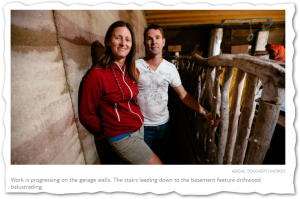Cool list of 10 types of buildings that are certified passive houses that you might not consider as ‘houses’. Remember the standard is an energy performance and quality standard and can apply to ANY building type. I’m sure there is a Yoga Studio and Spa in the works somewhere. Would love to see NZ step up to a Certified Passive …
2019 October 24 Stuff: DIY Rammed-Earth Passive House Involves Plenty Of Sacrifice

It’s great to see the progress Rochelle and Joel have made on their home. I grew up with a DIY-builder father, so I know how disruptive it can be to live in a construction site. We’ve helped out on other rammed earth projects, but theirs is the only one targeting Passive House Certification. “Rochelle and Joel Payne of Beachlands, Auckland …
2019 October 21 Passive House Institute : Two New Zealand Window Manufacturers Win Certified Component Awards At The International Passive House Conference (China 2019)

I was happy to accept the TWO awards for Thermadura (Dunedin) and SEDA (Auckland) for their certified timber aluminium window systems. This is an incredibly competitive event and I was proud NZ manufactures scored two out of the four awards for the warm, temperate climate. Details of the competition and links below: “The 1st Prize Timber Aluminium in warm, temperate …
2019 October 18 ASHRAE: Drop It Low: 2019 LowDown Showdown Winning Design Increases Resiliency, Minimizes Environmental Impact
This is another example of the ongoing shift from an engineering focus on saving energy to saving carbon. In order to do this properly, system engineering needs to be emphasized to an even greater extent using multi-disciplinary optimization (MDO). “The goal of the annual LowDown Showdown design challenge is to model buildings that get as close to zero energy as …
2019 October 16 The Fifth Estate: Passivhaus Social Housing Project Wins Stirling Prize For Architecture
Great article by Australia writer David Thorp on a Passive House social housing project in the UK. Delightful, lovely, socially connected and award-winning Passive House homes. “Mikhail said that he hopes this will give a new dynamic to the construction of council housing in the UK. “At this time when we have a housing and climate change crisis we need …
2019 October 16 Stuff: ‘Heavy Burden’ Of Living In Mouldy And Damp Homes, Landlords Still Installing Insulation
“When the family bought their home, it was newly built. Over time, they saw mould on the ceiling and their roof began to leak, damaging their insulation. Their children began to have breathing problems and their home required constant maintenance.” Installing a heat pump is likely to significantly dry out their home as it will be cheaper to open windows more. …
2019 October 16: News just in from China

Jason Quinn reported back from the 23rd International Passive House Conference: “Technical PH people used to talk about saving energy—but at the conference, I kept hearing about saving carbon. That’s a big shift. The conference was as technically awesome as ever but everything in China scaled up. There was the conference dinner (2000 people and a full orchestra) and the …
2019 October 15 The Fifth Estate: Passive House Celebrated at Victorian Premier’s Sustainability Awards
“Passive House certified accommodation for Monash University students has taken out the Built Environment category at this year’s Victorian Premier’s Sustainability Awards held in Melbourne last week.” I expect that in the next few years all the buildings winning will be certified Passive House buildings. This is a great first example of extraordinary low operating energy of Passive House, as …
2019 October 5 Stuff: Regulation Needed To Push Owners To Reduce Fossil Fuels In Buildings, Expert Says
“Government regulation will be needed to achieve net-zero carbon buildings says architectural engineering professor Larry Bellamy.” Let’s hope those regulations are good ones that take building physics into account and don’t allow system-wide poor choices. I push energy efficiency every day—it’s what I do—but increased energy efficiency requires better building practices, not just stuffing in more insulation. Read more on …






